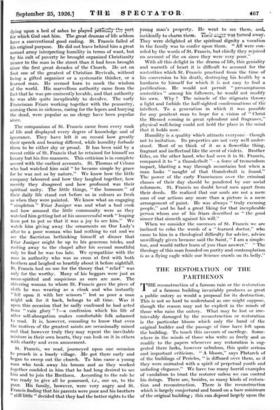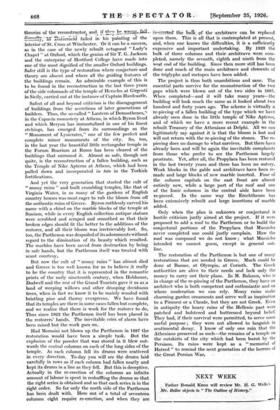THE RESTORATION OF THE PARTHENON T HE reconstruction of a famous
ruin or the restoration of a famous building invariably produces as great a public outcry as would a proposal for its destruction. This is not so hard to understand as one might suppose, though the reason may not be explicit in the minds of those who raise the outcry. What may be lost or irre- trievably damaged by the reconstruction or restoration is the particular bloom which only the hand of the original builder and the passage of time have left upon the building. To touch this savours of sacrilege. Some- where in the minds of those who write so freely and so readily to the papers whenever any restoration is sug- gested there lurks, however nebulous, this quite serious • and important criticism. "A bloom," says Plutarch of of the buildings of Pericles, "is diffused over them, as if they were animated with a spirit of perpetual youth and unfading elegance." We have too many horrid examples of vandalism to trust the restorer unless we can control his doings. There are, besides, so many kinds of restora- , tion and reconstruction. There is the reconstruction which is largely conjectural and based on a bare minimum of the original building ; this can depend largely upon the theories of the reconstructor. and. if th,q, wrsma_fail_ MU-ern-cid failed in his painting of the interior of St. Cross at Winchester. Or it can be a success, as in the case of the newly rebuilt octagonal "Lady's Chapel " at Oxford, which the genius of Sir T. G. Jackson and the enterprise of Hertford College have made into one of the Most dignified of the smaller Oxford buildings. Safer still is the type of restoration where conjecture and theory are absent and where all the guiding features of the buildings remain. An admirable example of this is to be found in the reconstruction in the last three years of the side colonnade of the temple of Heracles at Girgenti in Sicily, carried out at the instance of Captain Hardcastle.
Safest of all and beyond criticism is the disengagement of buildings from the accretions of later generations of builders. Thus, the so-called "Lantern of Demosthenes," in the Capuein monastery at Athens, in which Byron lived and which Meryon has immortalized in one of his finest etchings, has emerged from its surroundings as the "Monument of Lysicrates," one of the few perfect and complete minor monuments of the city. So, too, in the last year the beautiful little rectangular temple in the Forum Boarium at Rome has been cleared of the buildings that surround it. Almost as safe, though not quite, is the reconstruction of a fallen building, such as the Temple of Nike Apteros at Athens, which had been pulled down and incorporated in toto in the Turkish fortifications.
And yet the very generation that started the cult of "mossy ruins" and built crumbling temples, like that of Virginia Water, in so many of the gardens of English country houses was most eager to rub the bloom from off the authentic ruins of Greece. Byron ruthlessly carved his name with a chisel on the marble blocks of the temple at Sunium, while in every English collection antique statues were scrubbed and scraped and smoothed so that their broken edges should fit the better to the additions of the restorer, and all their bloom was irretrievably lost. So, too, the Parthenon was despoiled of its adornments without regard to the diminution of its beauty which resulted. The marbles have been saved from destruction by being in safe hands, but the Parthenon itself was treated with scant courtesy.
But now the cult of "mossy ruins" has almost died and Greece is too well known for us to believe it really to be the country that it is represented in the romantic prints of the early nineteenth century, when Hobhouse, Dodwell and the rest of the Grand Tourists gave it us as_a land of weeping willows and other, drooping deciduous trees, when in fact we know it to be mainly wooded with bristling pine and thorny evergreens. We have found that its temples are there in some cases fallen but complete, and we realize that there is work for the restorer to do, Thus since 1922. the Parthenon. itself has been placed in the restorers' hands. _ The inevitable cries of alarm have been raised but the work goes On. .
Had Morosini not _blown up the Parthenon in 1687 the restoration would have been a simple task. But - the explosion of the powder that was stored in it blew out- wards the central columns on each of the long sides of the temple. As each column fell its drums were scattered in every direction. To-day you will see the drums laid carefully in rows as if each column had fallen neatly. and kept its drums in a line as they fell. But this is deceptive. Actually in the re-erection of the columns an infinite amount of labour is spent in reshuffling the drums so that the right series is obtained and so that each series is in the right order. So far only the north side of the Parthenon has been dealt with. Here Out of a total of seventeen columns eight require re-erection, and when they are the bulk. of the architrave can be replaced upon them. This is all that is contemplated at present, and, when one knows the difficulties, it is a sufficiently expensive and important undertaking. By 1928 the bulk of three columns and their architrave were com- pleted, namely the seventh, eighth and ninth from the west end of the building. Since then more still has been done and much of the main architrave and elements of the, triglyphs and metopes have been added. • The project is thus both unambitious and sane. The essential parts survive for the reconstruction of the two gaps which were blown out of the two sides in 1687. When completed—and it will take many years—the building will look much the same as it looked about two hundred and forty years ago. The scheme is virtually a re-piecing of a fallen building of the type which we have already seen done in the little temple of Nike Apteros; and of which we have a more recent example in the rebuilt Treasury of the Athenians at Delphi. All we can legitimately say against it is that the bloom is lost and will not return with the re-piecing of the stones. The re- piecing does no damage to what survives. But there have already been and will be again the inevitable complaints from those who prefer to see the Parthenon largely prostrate. Yet, after all, the Propylaea has been restored in the last twenty years and there has been no outcry. Weak blocks in the gable and architrave have been re- made and large blocks of new marble inserted. Four of the column capitals on the east front are almost entirely new, while a large part of the roof and one of the Ionic columns in the central aisle have been re-pieced. In the same way the Erechtheum has been extensively rebuilt and large insertions of marble added.
Only when the plan is unknown or conjectural is hostile criticism justly aimed at the project. If it were proposed to add a roof to the Parthenon or to build the conjectural portions of the Propylaea that Mnesieles never completed one could justly complain. How the roof was composed we do not know ; what Mnesieles intended we cannot guess, except in general out- line.
The restoration of the Parthenon is but one of many restorations that are needed in Greece. Much could be done at Bassae, at Olympia, at Corinth. The Greek authorities are alive to their needs and lack only the money to carry out their plans. In M. Balanos, who is in charge of the re-piecing of the Parthenon, they have an architect who is both competent and enthusiastic and on whose moderation we can rely. Mossy ruins make charming garden ornaments and serve well as inspiration to a Piranesi or a Claude, but they are not Greek. Even in antiquity the hoary ruins of the Hellenic past were patched and bolstered and buttressed beyond belief. They had, if their survival were permitted, to serve some useful purpose ; they were not allowed to languish in sentimental decay. I know of only one ruin that the Athenians preserved as such—the remains of a temple on the outskirts of the city which had been burnt by the Persians. Its ruins were kept as a "memorial of Hatred" to remind the nextgeneration of the horrors of the Great Persian War.















































 Previous page
Previous page